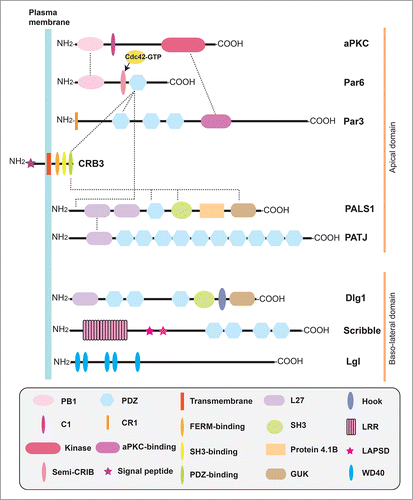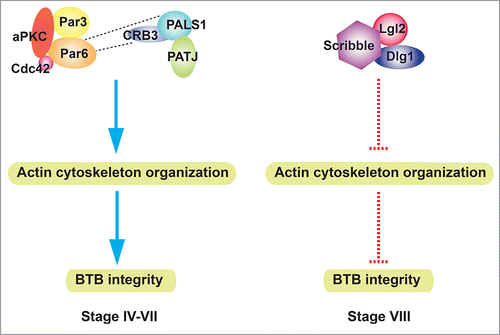Figures & data
Figure 1. A schematic drawing that illustrates some common functional domains in component proteins of the Par-, CRB- and Scribble-based polarity protein complexes. Based on studies in the testis, the Par-based polarity protein complex is constituted by Par6, Par3, aPKC and Cdc42-GTP, whereas the CRB3-based polarity complex is composed of CRB3, PALS1 and PATJ. Furthermore, there are extensive interactions between Par- and CRB3-based protein complexes via the corresponding protein domains. The Scribble-based polarity complex consists of Scribble, Lgl2 and Dlg1. Abbreviations used: Par, partitioning defective; aPKC, atypical protein kinase C; PB1 domain, Phox and Bem1 domain; C1 domain, protein kinase C conserved region 1; Kinase, kinase domain; Semi-CRIB, semi-Cdc42/Rac interactive binding motif; PDZ domain, PSD-95/Discs large/ZO-1 (PDZ) domain; CR1, conserved region 1. CRB, Crumbs; PALS1, protein associated with Lin-7 1; PATJ, PALS1 associated tight junction protein; FERM-binding domain, protein 4.1/ezrin/radixin/moesin-binding domain; L27 domain, Lin2 and Lin7 binding domain; SH3 domain, Src homology domain 3 domain; GUK domain, Guanylate kinase domain; Dlg, Discs large; Lgl, Lethal giant larvae; LRR repeats, leucine-rich repeats; LAPSD, LRR and PDZ specific domain. WD40, tryptophan-aspartic acid (WD) 40 repeats.

Figure 2. A schematic model that illustrates the antagonistic effect of CRB/Par-based polarity complex vs. Scribble-based polarity complex at the BTB. Par- and CRB3-based polarity complexes are highly expressed at the BTB from stages IV-VII. These two complexes directly interact with each other, and they both stabilize actin network and promote BTB integrity. At stage VIII, Par- and CRB3-based complexes are diminished at the BTB, whereas Scribble-based complex is highly expressed. Scribble complex disrupts actin cytoskeleton organization, thereby disrupting BTB integrity. Blue arrow, stabilization/promotion; red dash line, inhibition/disruption.

